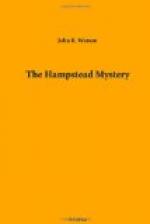The junior bar agreed that the case was one which might go either way. If they had possessed any money the betting market would have shown scarcely a shade of odds. Everything depended on the way the jury looked at the case, on the particular bits of evidence to which they attached most weight, on the view the most argumentative positive-minded members of the jury adopted, for they would be able to carry the others with them. In the opinion of the junior bar the summing up of Mr. Justice Hodson would not help the jury very much in arriving at a verdict. There were some judges who summed up for or against a prisoner according to the view they had formed as to the prisoner’s guilt or innocence. There were other judges who summed up so impartially and gave such even-balanced weight to the points against the prisoner and to the points in his favour, as to make on the minds of the jurymen the impression that the only way to arrive at a well-considered verdict was to toss a coin. Another type of judge conveyed to the jury that the prosecution had established an unanswerable case, but the defence had shown equal skill in shattering it, and therefore he did not know on which side to make up his mind, and fortunately English legal procedure did not render it necessary for him to do so. The prisoner might be guilty and he might be innocent. Some of the jury might think one thing and the rest of the jury might think another. But it was the duty of the jury to come to an unanimous verdict. It did not matter if they looked at some things in different ways, but their final decision must be the same.
Mr. Justice Hodson belonged to the impartial, impersonal type of judge. He had no personal feelings or conviction as to the guilt or innocence of the prisoner. It was for the jury to settle that point and it was his duty to assist them to the best of his ability. He went over his notes carefully and dealt with the evidence of each of the witnesses. It was for the jury to say what evidence they believed and what they disbelieved. There was a pronounced conflict of evidence between Hill and Fanning. They were the chief witnesses in the case, but the guilt or innocence of the prisoner did not rest entirely upon the evidence of either of these witnesses. Hill might be speaking the truth and the prisoner might be innocent though the presumption would be, if Hill’s evidence were truthful in every detail, that the prisoner was guilty. Fanning’s evidence might be true as far as it went, but it would not in itself prove that the prisoner was innocent. Hill had admitted that he had drawn the plan of Riversbrook to assist Birchill to commit burglary. It was for the jury to determine for themselves whether he had been terrorised into drawing the plan for Birchill or whether he was the instigator of the burglary.




